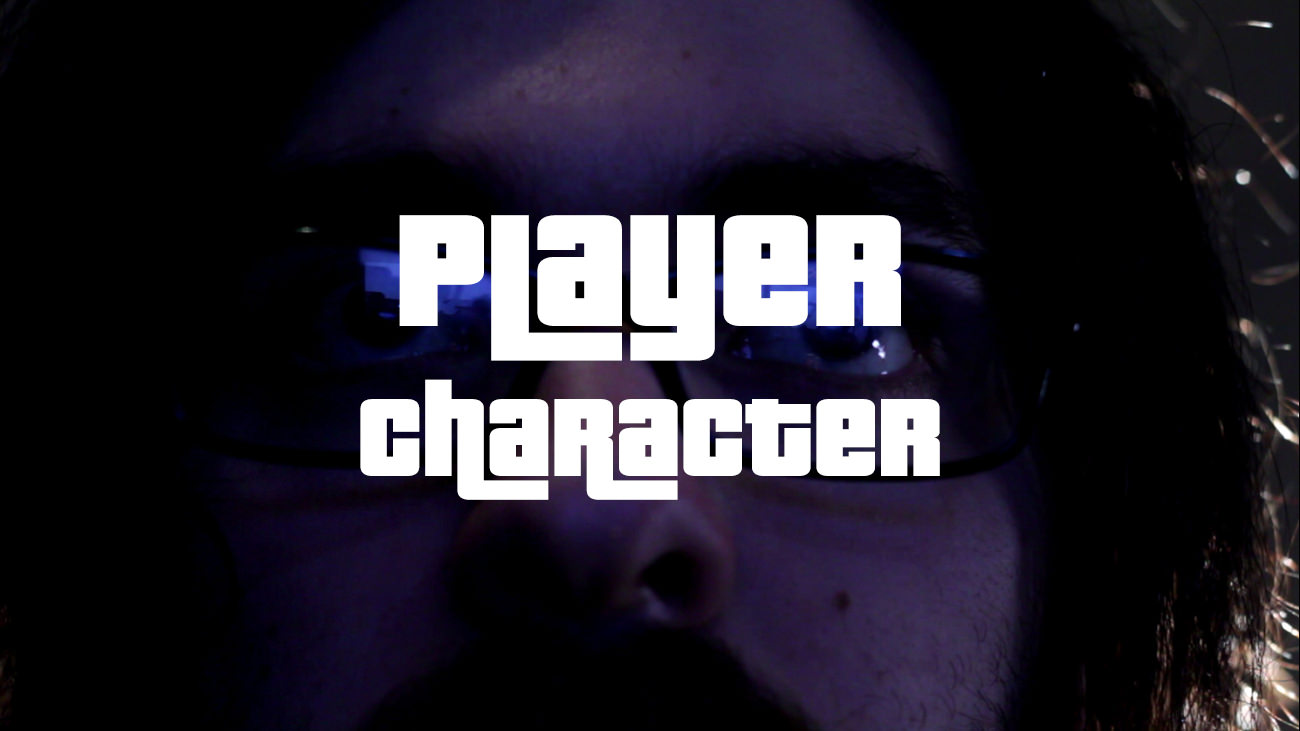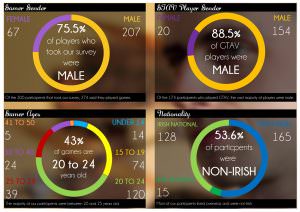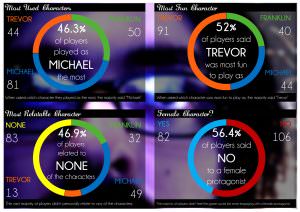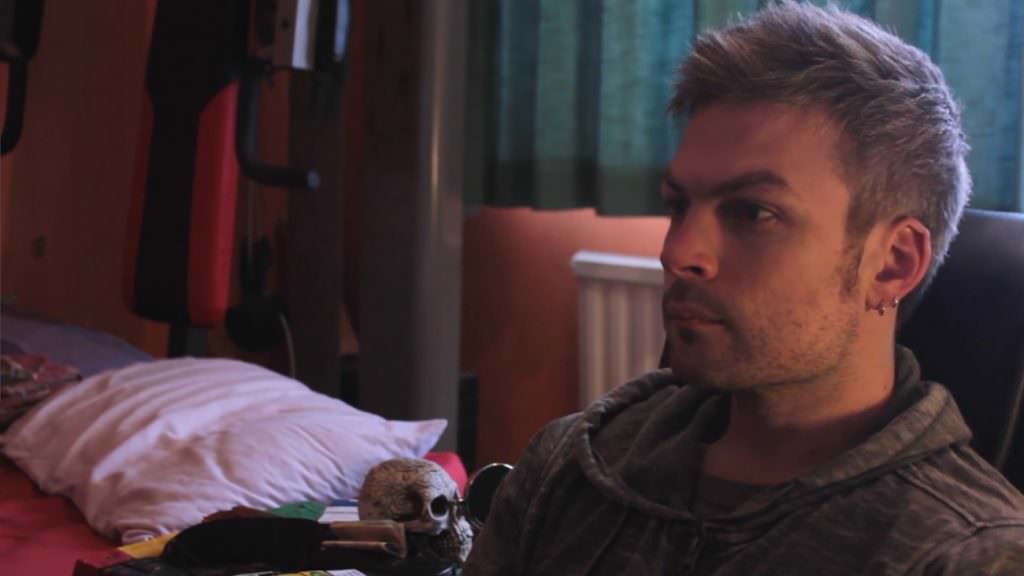“Player Character” is a short film that contrasts the deeply disturbed, negative gamer stereotype and how he enjoys his games (as mass-murder aids), against today’s actual gamers, and how they really enjoy their games.
Read what went into this video below!
Player Character from Player Character on Vimeo.
Video games, as youthful as they are, are an under-examined medium, academically and critically speaking. It’s all well and good for writers to look at them as products and pound-for-pound, hour-for-hour pieces of distraction, but to look at them on a more artistic or cultural level is something that has only just begun to happen in a big way.
With the current wave of feminist and theory-heavy critics breaking down what games mean socially and dissecting the techniques designers use to evoke reactions from the player, many people are discovering a lack of vocabulary to describe games and their effect.
Last year in 2014, 3 team-mates and I performed a study of our own. While we were film and media students, we all happened to be just as passionate about games as we are about film, and at the tail-end of 4 years of film theory largely focused on representational issues, we wanted to do the same with video games.
We also had a bit of a grudge against how news and film tends to portray gamers as all-male grotesque, socially inept, brain-rotted nerds at best, and psycho-killer, school-shooter Satanists at worst. Rather than fall into that trap, we wanted to see who is actually playing games these days, what they’re like and if playing as Trevor Philips causes them to go on a bloody rampage in real life.
Shockingly”, the results weren’t as dramatic as the NRA or any Video Game Nasty nanny wants you to think.
Using Grand Theft Auto V as a basis due to it’s ridiculously successful sales and free-form sandbox style, we had 3 research methods to see who is playing these games and how they interact with the characters. We wanted to find out how players got immersed; if they thought they were the characters while playing, if they were simply watching from a distance, or perhaps some other form of identification.
Does the act of controlling a character bypass the kind of empathy and identification you need with a film protagonist to enjoy it, or does not looking like Michael, Franklin or Trevor make it harder to enjoy the game?
Or, to put it simply; which is more important: gameplay or narrative?
We had three research methods:
- We conducted an online survey to gather statistics.
- We sat 9 volunteers down and observed them play GTAV whichever way they felt fit
- And interviewed them afterwards about why they did what they did, if they like the characters and why, etc.
Lastly, we also slogged through a collection of mostly god-awful films and tv shows about gamers or featuring the stereotype as gag-characters (avoid “noobz” and “Law & Order: SVU” like the plague, but definitely watch “Spaced“) to build our own stereotypical nerd. All of this culminated in the above video where we contrasted that stereotype in a scripted scene against actual gamers, using the audio of our interviews to make up the bulk of the documentary.
Of course, when reading this or any study, you need to keep in mind that it does not take place in a vacuum and doesn’t count for every gamer everywhere ever. Nothing in it is perfectly objective, or perfectly applicable to your corner of the world. For instance, our survey was heavily slanted towards Irish audiences, seeing how we went to college in Ireland and all.
All we hoped to do with this study was open up the dialogue more, particularly amongst media theorists and non-gamers.
That all said, allow me to briefly summarise what we found. The full official study will be available soon, but here is a small sampling of some interesting finds that by no means encapsulate the entire study.
The Survey
With a total of 300 participants in the end, we set up our questionnaire on SurveyMonkey and distributed it through Facebook, tumblr, a mailing list, and two forums; a general games forum and a GTA fan site. We asked simple quantifiable questions (“What age are you? – Do you play games? – What platforms do you use?”) and more abstract, opinion-based questions (“Which character is most fun to play as? – Why?”) that covered both gamers in general and later focused specifically on GTAV.
- Of the 274 participants who played games, 67 (24.5%) were female, 207 (75.5%) were male.
- Of the 174 gamers who played GTAV, 20 (11.5%) were female, while 154 (88.5%) were male.
The second statistic was little surprise as GTA has always been heavily marketed towards men, which has garnered criticism with it’s latest release. However having under one quarter of general gamers being female was lower than we expected.
- The vast majority (43%) of participants were between 20 and 24.
- On average, the majority (36%) played games for under 3 hours a day.
- Consoles were the most used platform (198), followed by laptop (81), phone (77), handheld (58), tablet (33) and PC (29)
Again, no real surprise here, but it gives an insight as to who our average participant was; a male in his early 20s who prefers consoles and plays for under 3 hours a day on average.
- The majority (81) played as Michael most, followed by Franklin (50) and Trevor (44) respectively.
- The majority (83) couldn’t relate to any character, followed by Michael (49), Franklin (32) and Trevor (13)
- The majority (91) thought Trevor was the most fun to play as, then Michael (44) then Franklin (40)
This is probably the most interesting set of results from the survey. Despite the fact people play mostly as Michael and relate least to Trevor, people found him the most fun to play as. When asked why, most of the answers included reference to him being a “maniac”.
One answer put it best:
[Trevor] is, basically put, the representation of the way most gamers play Grand Theft Auto. You can feel comfortable and it won’t feel out of place to do nearly anything with him from driving calmly to jumping off Mount Chilliad in your underpants
The narrative aspects of each character and how they function in-game isn’t separate. Trevor is an unstable berserker and better suited for rampages, Franklin is a collected racer and better suited for driving and Michael is a sneaky bank robber and better suited for more cool and tactical shootouts. When asked why they thought a character was fun though, most players referenced their personality or their narrative arch.
So perhaps a strong story or writing of a character is what provides the most immersion in these types of games.
What was important to take away from our findings is that players had the most fun with the crazy character they identified least with. This is contrary to what the stereotypical, news and film gamer stereotype thinks; that they are the killer, that they get so immersed they confuse virtual reality with actual reality and may start to act in deeply negative ways.
It is, of course, not true; most gamers are aware their favourite characters are outlandish, fictional things that are simply fun to play around with and didn’t have to be like them at all.
This is important when it comes to the ever-hot topic of gender in games as 43.6% of people who answered said the game would be more engaging with a female protagonist, despite those answers coming mostly from men. Considering that a character apparently doesn’t need to be like the player in order for them to enjoy the game, this point to the under-representation of women being more of a problem with marketing…
The Observed Gameplay Session
Following our survey, we got 9 people (3 girls, 6 guys) to sit down with the game for an hour while we watched them play and took notes on what they did and how they reacted to the game.
As strange as initially it was for players to be watched as they play, and how some of them might have acted differently to perform for us, it took an estimated 15 to 20 minutes for each player to get fully sucked in.
We set up everything so that each player had complete freedom to do what they wanted, giving them a 100% completed save to start off, meaning they had access to all the characters, weapons, vehicles and replayable missions the second they sat down.
And not a single one of played the same way as the other.
- One played set-up missions only, driving in the bumper camera view, extremely cautiously to avoid hitting pedestrians, sitting through each cutscene and laughing at the dialogue.
- Another just wanted to have shoot outs with the cops from the back of the train, getting a bit embarrassed whenever he died, and had the chat with us as he played.
- Another player just wanted to go on total chaotic rampages, delighted when she found the hammer for the first time, laughing at the slapstick when pedestrians and cops were sent flying, or when a cougar blind-sided her.
- One of the girls had a relaxed roam around, customising her character, going to the cinema and trying to see what little easter-egg type bonuses she could find within the hour, chatting as she went.
- A particular player tried to start the craziest car chases possible, getting a bit disappointed when he was Wasted a few times before giving up and hunting deer, feeling a bit bad for it due to how cute they thought they were.
- And finally, one guy tried his hardest to do as many unthinkable things he could within the hour, such as trying to steal a commercial plane, kicking a pedestrian off a cliff and trying to hijack the train, religiously punching the first pedestrian outside the hospital each time he respawned.
When doing a study like this, you hope to find some sort of clear trend that the player is unconscious of that’ll tell you what draws everyone in. Yet even violence and action wasn’t something every participant indulged in, with two of them have very laid back sessions.
One interesting thing we noticed was an almost 50-50 split between players being more interested in narrative aspects or gameplay aspects, with some opting to play story missions or do character-specific things, and some just picking any random character and doing whatever they could between exploration and rampages. The latter group were more likely to play in a crowd, with two of the girls having never played the game in any other way on their own time.
It’s a testament to the complexity and staggering scale of GTAV that each of our 9 players could do something subtly different than the rest even if they all, for instance, wanted to start a shoot out as the same character.
The Interviews
Following the gameplay sessions, we asked the players themselves what their opinions on the characters and how they interact or identify with them were. While we observed more unconscious behaviour before this, asking them to take part in a more aware, self-conscious interview was another angle to look at immersion from.
As with the previous bit of research, the answers were as varied as their style of play.
What it is about a particular character that causes the player to identify with them is different for every individual. Some players didn’t care for their personality, their story or how they looked and were only interested in good gameplay. Some could point out traits they had in common with their favourite character, some enjoyed indulging themselves in the role despite being totally in disagreement with it.
One of the female players said this about Trevor:
He didn’t really feel any guilt when he killed people – So I feel when you’re playing as him you kinda pick up on that. You don’t feel as bad maybe killing people. You’re just like ‘Trevor would do it so…ok’.
While she completely disliked Trevor as a person, it shows something unique about the medium that games like Metal Gear Solid and Spec Ops: The Line have used in their stories; the player’s need to place responsibility for their dubious actions in a character can be an integral part to the experience.
We found that a good level of customisation (of a character’s clothes, hair, tattoos, cars, etc) were what made players more attached to the character.
From another player:
“Because of the narrative it’s easier to get friendly with them but you see them more as friends rather than yourself, so you’re not playing as yourself in the game, you’re playing as someone else. You don’t have the feeling that it’s you, that you’re building your own character. It’s literally you’re building someone else’s premade character”.
Most importantly, none of our participants said they thought they actually were the characters, nor did any think that they even wanted be like them, even if they did relate in some way.
The implication of this, aside from being another piece that dispels the tired “video game caused my son to shoot his teacher” tabloid articles, is that gamers can quickly and easily get past or work around things like their character’s gender, race or even their species when playing.
The Short Film
At the end of all this research, the only thing left for us to do was make a short film out of it. Calling back some of the participants to play in front of the camera and using recordings of the interviews to make up the bulk of the dialogue, we contrasted the diversity not only of the players themselves, but how they played, what they made of the characters and what games do for them as individuals against the tired media stereotype of gamers being slovenly psychopaths just ticking over in their game until their real life murder-spree begins.
As mentioned earlier, we took a selection of films and tv shows with gamer characters and looked for common elements to build our own gamer stereotype, whom we aptly named “Melvin”. An white 20-something male with glasses, poor personal hygiene and murderous, serial-killer type fantasies…..which in truth isn’t too far off who the common gamer might be.
However, the main element we found untrue when stacked against our survey was the level of chronic addiction these characters tend to have with their games, that the game takes over their life. That, of course, is something that does happen in the real world, but not with the kind of frequency as it does in the media.
We watched the films Reign Over Me, noobz, Stay Alive, Cloak & Dagger, Gamer and Grandma’s Boy. For tv shows, we took individual episodes of Spaced, Breaking Bad, Law and Order: SVU, South Park, CSI: NY and The Middle. Naturally, the most exaggerated examples of the stereotype tend to be once-off or gag characters, such as the nameless World of Warcraft player in South Park or Kenny in The Middle, two characters who don’t have a single line of dialogue.
It is, however, a tired and increasingly inaccurate stereotype that covers less and less of the gaming demographic as time marches on.
In our short, we wanted to put “Melvin” to rest. By the end, after showing actual gamers and using recordings of our interview, we amped up the ridiculousness to 11 and parodied Psycho, having even Melvin put down the controller and say “it’s just a game” while leaving his cave to do something else for a change.
Conclusion
Throughout our study, we found that while there was a grain of truth to the stereotype (with the majority of players being 20-something males), the way it has been portrayed through the years has been overblown and irrational. Pointing at games as being the sole source of psychotic behaviour is ridiculous.
Most of our survey participants cited narrative aspects as being a draw for immersion or connection to their characters, yet each of the players in the gameplay session had their own unique flare to how they played.
It is likely impossible to talk in absolutes about what games do to people, and throughout our study on Grand Theft Auto V we found a myriad of paths the research could have went down. We just barely scratched the surface of this game alone, disregarding the Online mode and the fan community entirely.
Even this article is a condensed version of what we found, and the discussion could continue into issues of race, marketing, fan-participation and so on.
All we can say with 100% certainty is that GTAV and games in general are still critically under-examined. What we’ve hopefully provided is food for thought and we hope you can join the conversation about not just this game and other games, but the people who play them today.
A PDF of the full study and all our research material will be made available soon. If you thought this read was interesting and want to know more, keep your eyes peeled!























